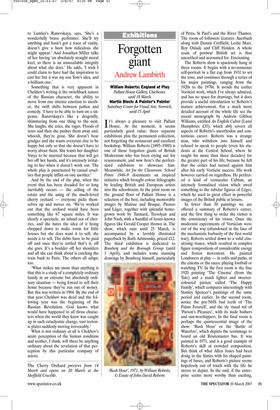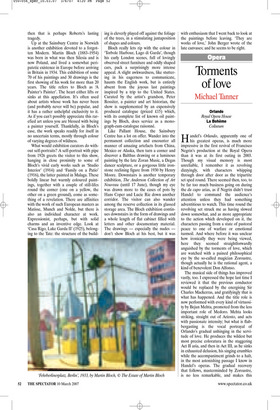Forgotten giant
Andrew Lambirth
William Roberts: England at Play Pallant House Gallery, Chichester, until 18 March Martin Bloch: A Painter’s Painter Sainsbury Centre for Visual Arts, Norwich, until 15 April It’s always a pleasure to visit Pallant House. At the moment, it seems particularly good value: three separate exhibitions plus the permanent collection, not forgetting the restaurant and excellent bookshop. William Roberts (1895–1980) is one of those forgotten giants of British Modernism who has been crying out for reassessment, and now here’s the perfectsized exhibition to showcase him. Meanwhile, Art for the Classroom: School Prints 1946–9 documents an inspired initiative which brought colour lithographs by leading British and European artists into the schoolroom. In the print room on the ground floor of Pallant House is a selection of the best, including memorable images by Matisse and Braque, Picasso and Léger, together with splendid homegrown work by Tunnard, Trevelyan and John Nash, with a handful of lesser-known figures like Gerald Cooper thrown in. The show, which runs until 25 March, is accompanied by a lavishly illustrated paperback by Ruth Artmonsky, priced £12. The third exhibition is dedicated to Bomberg and the Borough Group (until 1 April), and includes some stunning drawings by Bomberg himself, particularly of Petra, St Paul’s and the River Thames. The room of followers features Auerbach along with Dennis Creffield, Leslie Marr, Roy Oxlade and Cliff Holden. A whole seam of postwar British art is thus unearthed and accounted for. Fascinating.
The Roberts show is spaciously hung in three rooms. It begins with a no-nonsense self-portrait in a flat cap from 1931 to set the tone, and continues through a series of his major paintings, ranging from the 1920s to the 1970s. It avoids the earlier Vorticist work, which I’ve always admired, and has no space for drawings, but it does provide a useful introduction to Roberts’s mature achievement. For a much more detailed account of the whole life see the recent monograph by Andrew Gibbon Williams, entitled An English Cubist (Lund Humphries £35), which ably covers all aspects of Roberts’s unorthodox and contentious career. Roberts was a strange man, who withdrew into himself and refused to speak to people (even his students at the Central School, where he taught for more than three decades) for the greater part of his life, because he felt that the critics had turned against him after his early Vorticist success. His work however carried on regardless. He perfected a kind of vernacular Cubism, an intensely formalised vision which owed something to the tubular figures of Léger, which he used to great effect in powerful images of the British public at leisure.
In fewer than 30 paintings we are offered a summary of Roberts’s career, and the first thing to strike the viewer is the consistency of his vision. Once the modernist experiments of Vorticism were out of the way (abandoned in the face of the mechanistic barbarity of the first world war), Roberts settled down to a solid classicising stance, which resulted in complex figure compositions of considerable energy and frozen movement. He painted Londoners at play — in cafés and parks, at the cinema or the races, playing football or watching TV. In the first room is the fine 1920 painting ‘The Cinema’ (from the Tate) and a much lighter and sweetercoloured picture called ‘The Happy Family’, which compares interestingly with Stanley Spencer’s paintings of the same period and earlier. In the second room, notice the pre-NHS bad teeth of ‘The Palms Foretell’, and the sly visual wit of ‘Parson’s Pleasure’, with its nude bathers and sun-worshippers. In the final room is perhaps the quintessential image of the show: ‘Rush Hour’ or the ‘Battle of Waterloo’, which depicts the scrimmage to board an old Routemaster bus. It was painted in 1971, and is a good example of Roberts’s skill at crowded composition. But think of what Allen Jones had been doing in the Sixties with his shaped paintings of buses, and Roberts’s picture seems hopelessly out of touch with the life he strove to depict. In the end, if the enterprise seems more worthy than exciting, then that is perhaps Roberts’s lasting tragedy.
Up at the Sainsbury Centre in Norwich is another exhibition devoted to a forgotten Modern. Martin Bloch (1883–1954) was born in what was then Silesia and is now Poland, and lived a somewhat peripatetic existence in Europe before arriving in Britain in 1934. This exhibition of some 70 of his paintings and 30 drawings is the first showing of his work for more than 20 years. The title refers to Bloch as ‘A Painter’s Painter’. The heart either lifts or sinks at this appellation. It’s often used about artists whose work has never been (and probably never will be) popular, and it has a rather unhelpful exclusivity to it. As if you can’t possibly appreciate this rarefied art unless you are blessed with being a painter yourself. Thankfully, in Bloch’s case, the work speaks readily for itself in no uncertain terms, mostly through colour of varying degrees of wildness.
What would exhibition curators do without self-portraits? A self-portrait with pipe from 1926 greets the visitor to this show, hanging in close proximity to some of Bloch’s vivid early works such as ‘Studio Interior’ (1914) and ‘Family on a Patio’ (1916), the latter painted in Malaga. These boldly linear but warmly coloured paintings, together with a couple of still-lifes round the corner (one on a yellow, the other on a green ground), come as something of a revelation. There are affinities with the work of such European masters as Matisse, Munch and Nolde, but there is also an individual character at work. Expressionist, perhaps, but with solid charms and an inventive edge. Look at ‘Casa Rigo, Lake Garda II’ (1925), belonging to the Tate: the structure of the build ing is cleverly played off against the foliage of the trees, in a stimulating juxtaposition of shapes and colours.
Bloch really lets rip with the colour in ‘Torbole Harbour, Lago di Garda’, though his early London scenes, full of lovingly observed street furniture and oddly shaped cars, pack a surprisingly more intense appeal. A slight awkwardness, like stuttering in his eagerness to communicate, haunts the English work, but is entirely absent from the joyous last paintings inspired by a trip to the United States. Curated by the artist’s grandson, Peter Rossiter, a painter and art historian, the show is supplemented by an expensively produced catalogue (priced £15) which, with its complete list of known oil paintings by Bloch, does service as a monograph-cum-catalogue raisonné.
Like Pallant House, the Sainsbury Centre has a lot on offer. Wander into the permanent collection and encounter all manner of amazing artefacts from China, Mexico or Alaska, then turn a corner and discover a Balthus drawing or a luminous painting by the late Zoran Music, a Degas dancer sculpture, or a gorgeous little ironstone reclining figure from 1930 by Henry Moore. Downstairs is another temporary exhibition, The Anderson Collection of Art Nouveau (until 17 June), though my eye was drawn more to the cases of pots by Hans Coper and Lucie Rie down another corridor. The visitor can also wander among the reserve collection in its glassed storage area. The Bloch exhibition continues downstairs in the form of drawings and a whole length of flat cabinet filled with letters and other documentary material. The drawings — especially the nudes — don’t show Bloch at his best, but it was with enthusiasm that I went back to look at the paintings before leaving. ‘They are works of love,’ John Berger wrote of the late canvases; and he seems to be right.



























































































 Previous page
Previous page